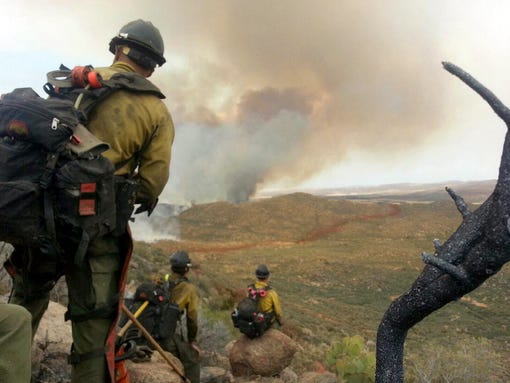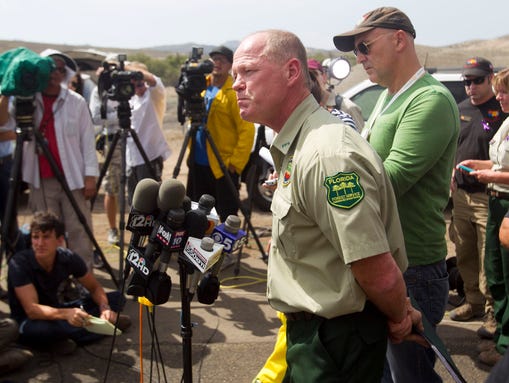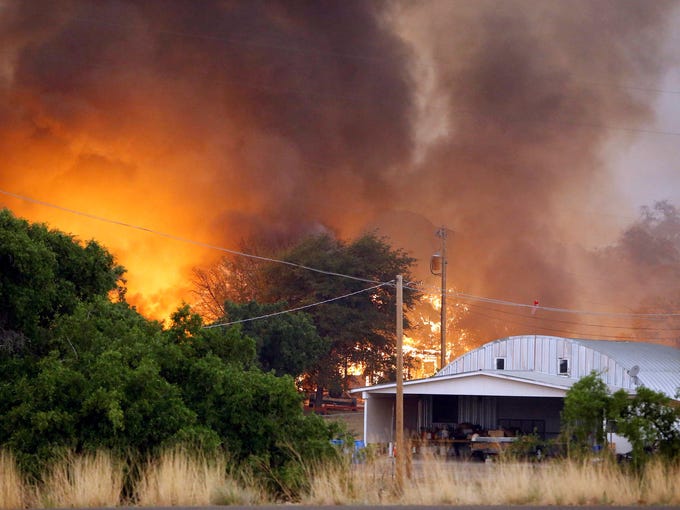This Has Also Happened In CA Before And Will Again!
Craig Harris and Dennis Wagner, The Arizona Republic 7:51 a.m. EDT September 29, 2013PHOENIX — An investigative report released Saturday on the Yarnell Hill Fire that killed 19 firefighters found "no indication of negligence, recklessness actions or violations of policy or protocol" on the part of the firefighters, and concluded that the fire that overtook the men was not survivable.
The report, released by the Yarnell Hill Fire Serious Accident Investigation Team, leaves unanswered a major question: Why the Granite Mountain Hotshots left the relative safety atop a ridge that had been previously burned to descend into a bowl where they were later trapped and killed.
"We don't have it. That decision-making process went with those men," said Florida State Forester Jim Karels, who led the investigation. "I try and step back and stand on that mountain where that crew was and try to figure out what they did and why."
Karels said the investigative team decided the firefighters "stayed within their boundaries and management made the best decisions they could make at the time they made them."
The report says that fire commanders assumed until just before the hotshots died that the team was still safely atop a nearby ridge "in the black," a reference to charred ground that has already burned.

In this file photo shot by firefighter Andrew Ashcraft, members of the Granite Mountain Hotshots watch a growing wildfire that later swept over and killed the crew of 19 firefighters near Yarnell, Ariz., June 30.(Photo: AP)
Arizona Gov. Jan Brewer issued a statement Saturday afternoon lamenting the tragedy.
"The Yarnell Hill Fire always will be remembered for the loss of our brave 19 firefighters from the elite Granite Mountain Hotshots. The tragic human toll felt by their families, friends and the community is truly immeasurable," Brewer said.
Karels and Mike Dudley, an investigator with the U.S. Forest Service, said the investigative team did not compile a report other than the one released Saturday. Officials said guidelines by the National Interagency Fire Center, which instruct those who conduct fatality inquires to keep confidential the causes of the tragedy, are just guidelines and that no other reports were drafted.
The report states temperatures exceeded 2,000 degrees Fahrenheit — the temperature of lava from a volcano — and the hotshots had less than two minutes to improve a deployment site and try to save themselves.
Read the full report on the Yarnell Hill Fire deaths
While the report laid no blame for the tragedy, it found that radio communications were "challenging throughout the incident" and that "some radios were not programmed with appropriate tone guards" but were later fixed. It also noted the command structure for fighting the fire changed several times in just 20 hours.
It also found there were mix-ups over air support. Investigators noted that one air tanker was grounded because of an oil leak. A second one was held on the tarmac as fire officials decided whether to send it to a dangerous fire near Kingman. However, the report found that lack of air support did not affect the outcome of the fire or cause the hotshots' deaths.
The Granite Mountain Hotshots were overcome by flames June 30 in a chaparral canyon about 35 miles south of Prescott when the fire, pushed by monsoon-storm winds, became an inferno and changed directions. The death toll was the highest from a U.S. wildfire in at least a half-century.
The Arizona Division of Forestry, which directed firefighting efforts, commissioned an interagency task force of experts headed by Florida forester Jim Karels to investigate causes and contributing factors to the catastrophe.

Jim Karels, a state forester with the Florida Forest Service, who was on the team to investigate the deaths of the 19 firefighters battling the Yarnell Hill Fire, addresses the media July 3.(Photo: David Wallace, The Arizona Republic)
"Our mission was to find out what happened and to discern the facts surrounding this tragedy to the best of our ability," Karels said. "We also hope this report facilitates learning within the wildland fire community in order to reduce the likelihood of repeating actions that contributed to the loss of life."
Karels said the 116-page report includes a "fact-based narrative of the incident and offers the investigation team's analysis, conclusions and recommendations." He added it includes a discussion section that is meant to facilitate understanding and learning by exploring various perspectives and issues that arose during the investigation.
The report was released publicly at 10 a.m. MT Saturday in Prescott, after being shared privately with family members of the firefighters and Gov. Jan Brewer.
The report found:
That no one asked the Granite Mountain Hotshots to move to a new location, where they were killed. Instead, the report assumes, "they decided this on their own, believing they could re-engage and help defend Yarnell."
The hotshots left a lunch spot and traveled southeast on the two-track road near the ridge top. Then, they descended from the two-track road and took the most direct route towards Boulder Springs Ranch, where investigators believe "the crew was attempting to reposition so they could re-engage."

On Sunday morning, June 30, the fire had kicked up and incident commanders began requesting tankers. They ordered two large tankers, or LAT, and one very large tanker, or VLAT. The large aircraft flew from Albuquerque and Durango, Colo., but both were diverted en route so they could serve the Dean Peak Fire southeast of Kingman.
Dispatchers ordered another tanker from Fort Huachuca and a huge C-130 from Pueblo, Colo., which was specially fitted to drop fire retardant. But the Pueblo flight was grounded by bad weather and the Fort Huachuca tanker didn't lift off until 10:33 a.m. By 11 a.m., the Yarnell Hill Fire had already consumed 1,500 acres.
Besides issuing findings, members of the review team are expected to reveal how they conducted the probe and whether they adhered to guidelines from the National Interagency Fire Center, which urges investigators not to publicly divulge causes of wildfire accidents.
Lightning ignited the Yarnell Hill Fire on June 28, and it remained seemingly calm for two days before a storm front descended and pushed a wall of flames through drought-cured hills at 12 mph. A relatively small brush fire that covered only a few hundred acres exploded across 13 square miles and swept into rural communities.

Hundreds of people were evacuated from Yarnell, Glen Ilah and Peeples Valley as flames destroyed 127 homes.
The hotshots, who had been hand-cutting firebreaks along the blaze's flank, were forced to retreat. Photographic evidence indicates they left the safety of a previously burned area and descended into a blind canyon where they were trapped by flames. The 19 men deployed protective shelters in a desperate bid to survive, but were overcome by a wall of fire so hot that it fractured boulders and incinerated vegetation.
In addition to the Serious Accident Investigation, the Arizona Division of Occupational Safety and Health is conducting a probe to determine whether workplace regulations were violated. That report must be completed by the end of the year.
The Yavapai County Sheriff's Office conducted an accident-scene review and obtained autopsy results, but many of those documents have not been released and are the subject of a public-records lawsuit filed by The Arizona Republic and KPNX-TV in Phoenix.
Within days of the tragedy, while investigations were underway, some experts and media outlets began offering opinions as to what went wrong. Among their assertions: The crew died because of a shortage of slurry tankers. The fire blew out of control because the response on June 28 and 29 was inadequate. The hotshots inexplicably violated safety rules, leading to their demise.
Wildfire-fatality reviews historically have confronted causality questions head-on, identifying contributing factors such as weather conditions and aberrant fire behavior along with command errors, equipment problems, communication failures and misjudgments by those who died. The inquiries are designed to establish "lessons learned" for training purposes.
In recent years, however, commanders and crews have become concerned that investigations may be used unfairly in criminal prosecutions or lawsuits directed at public servants who make instantaneous decisions in the heat of firefights.
Source: http://www.usatoday.com/story/news/nation/2013/09/28/yarnell-fire-report-fails-to-answer-key-question/2887903/--
Check out http://groups.yahoo.com/group/californiadisasters/
Read my blog at http://eclecticarcania.blogspot.com/
My Facebook: http://www.facebook.com/derkimster
Linkedin profile: http://www.linkedin.com/pub/kim-noyes/9/3a1/2b8
Follow me on Twitter @DisasterKim
__._,_.___







No comments:
Post a Comment